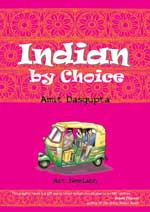THE ABC OF ABCDS
Indian by choice By Amit Dasgupta (Art: Neelabh), Wisdom Tree, Rs 995
Perhaps the first Indian graphic novel was Satyajit Ray’s screenplay for Pather Panchali. Ray’s frame-by-frame visualization of the film was a unique retelling of Bibhutibhushan’s classic, and a work of art in its own right, even if the film had not been made. Indeed, those who are sceptical of the graphic novel’s contemporary achievements regard it as the ideal form for vaguely creative people who cannot manage to write fiction, paint pictures or make films properly, but want to do a bit of all three.
It would be patently unfair to bring such scepticism to bear on Neil Gaiman’s darkly brilliant Sandman series or the work of Amruta Patil, Marjane Satrapi and Sarnath Banerjee (at his best). Yet, when Amit Dasgupta claims that Indian by Choice is “essentially in the style of a graphic novel” and that it “experiments” with the mixing of graphic illustration, text and photographs, then it does sound like a very tall claim. This large, hardcover book — its rani-pink dust-jacket splashed with kitsch and ludicrously over-the-top praise from big names in the Indian media — looks like a cross between a picture-book and a cook-book of the Incredible India kind that are sold in hotels and airports. Open it, and you will see nothing more than standard, computerized picture-making of less-than-minimal creativity, accompanied by barely disguised homilies on India, the World and, of course, Globalization, held together by the flimsiest excuse for a ‘plot’. There is a long afterword by Dasgupta that explains the book’s purpose: “it reaches out to the non-resident younger generation of Indians and to younger professionals who are increasingly having to engage with India for business and other reasons … it tells the story of India to the resident Indians, to our young generation and to tourists. Obliquely, it tries to answer the question: what is India?”
Indian by Choice tells the story of Mandy from Chicago (a copybook American-Born Confused Desi) visiting Delhi for a family wedding. He is actually called Mandeep, but starts out by hotly denying this fact — his own resistance to being coerced into sentimentalizing his Indian roots. Then, after his stay in Delhi and trips to Rajasthan, Goa and the JNU campus, chaperoned by an attractive cousin (who turns out to be adopted, and therefore beyond incest), Mandy gets over his psycho-cultural block and starts calling himself Mandeep. The dust-jacket calls this a “a journey of self-discovery through the myriad human relationships that helps us to see things in perspective and in context”. But the Dasgupta-Neelabh pair is no Jhumpa Lahiri, or even Bharati Mukherjee. They just have a better-than-average blurb-writer, who can make sub-mediocre expressions of neo-patriotism sound like a postcolonial Bildungsroman.
It is evident that Dasgupta is well-versed in the clichés that make up the jargon and imagery of a certain brand of globalized urban culture, conservative as well as liberal. But stereotypes (Indian, American and Indian-American), however smartly packaged (and Neelabh’s visuals are not smart enough), remain dead to the fictional imagination. They are devoid of even a modicum of human complexity, especially when yoked to a preachy and feel-good ideology. The idiom of this book would have been best for safe-sex or clean-air campaigns, in which simple and urgent messages have to be communicated to simple people with a short attention-span. But even social-awareness campaigns have moved on from this rudimentary stage and have learnt to be creative or, at least, clever.
AVEEK SEN
Subscribe to:
Post Comments (Atom)

No comments:
Post a Comment